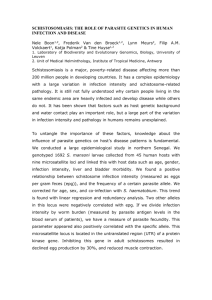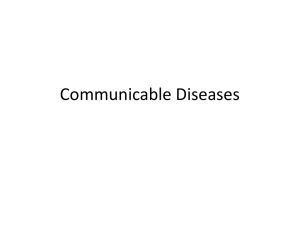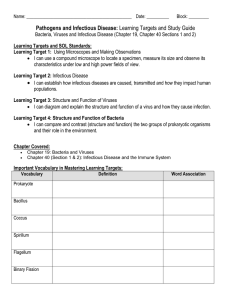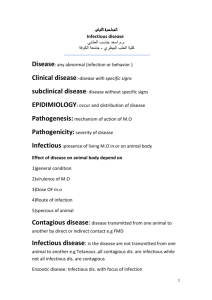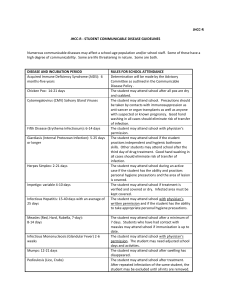PPT - Osenberg Lab
advertisement
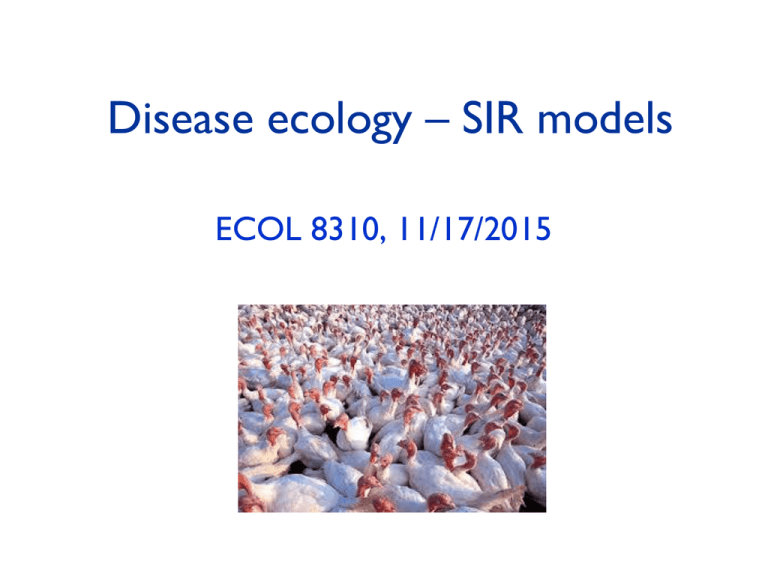
Disease ecology – SIR models ECOL 8310, 11/17/2015 Why do ecologists study host-parasite interactions? • Major regulator of wildlife population dynamics Control Trichostrongylus tenuis Lagopus lagopus scoticus 1 Treatment 2 Treatments Why do ecologists study host-parasite interactions? • Cause of decline for threatened and endangered species Mustela nigripes Omnivorous marsupials Even-toed ungulates Why do ecologists study host-parasite interactions? • Zoonoses are the main source of emerging infectious diseases in humans Jones et al. 2008 Epidemics Poliomyelitis in the USA Canine parvovirus in wolves in Minnesota Sequential epidemics Measles in England Rabies in red foxes in France 45 nm Culex pipiens Culex quinquefasciatus West Nile virus (extreme complications) in humans Key Concepts Models of disease dynamics • • • • • • • • The logic behind a compartment model Processes and rates Density-dependent transmission Disease invasion and R0 Threshold population sizes Frequency-dependent transmission Versions of SIR models Vaccination (Did Not Get To This) Compartmental model • Individuals in the population are classified – This matches epidemiological data • What are the possible classes? • What are the rates at which individuals move between them? Susceptible - Infected βSI S I The transmission term, β, determines how quickly individuals in the S compartment move into the I compartment Unstable equilibrium: (S*,I*) = (N,0) Stable equilibrium: (S*,I*) = (0,N) Transmission between hosts Contact rate Population size, N Athens Atlanta NYC We often assume a linear relationship between contact rate and population size e.g. the chances of bumping into someone on the sidewalk in different populations Contact rate = cN Transmission between hosts Transmission requires: i) Contact between individuals ✔ (cN) ii) The ‘right’ sort of contact (between an S and an I) iii) The parasite establishes in the new host For one infectious individual that makes contact with a random individual in the population, the chance that it is with a susceptible individual is S/N So for I infectious individuals, this scales up to (S/N)*I And we assume there is some (biologically determined) chance that this sort of contact allows the parasite to establish in the new host (call this chance ‘a’) Transmission requires: i) Contact between individuals ✔ (cN) ✔ (S/N)*I ii) The ‘right’ sort of contact (between an S and an I) iii) The parasite establishes in the new host ✔ (a) Expression for transmission = (cN)*(S/N)*I*a Research papers usually make the notation simpler by replacing the constants c*a by β, which is called the transmission rate Expression for transmission = βSI Infectious Period Infected Recovered γI I R This is the length of time that an individual is capable of transmitting infection to susceptible individuals Commonly, we use 1/γ for the infectious period, and rate of movement from I compartment to R compartment is γI After this time, the host’s immune system clears the virus, and this simple model assumes that hosts remain recovered SIR: The basic compartmental model S βSI I γI R • Examples: measles, chickenpox • Anything that only needs one course of vaccine • Equilibria depend on R0, can be endemic or epidemic SIR model with births and deaths S dS = d N - b SI - mS dt dI = b SI - g I - m I dt dR = g I - mR dt I R Here, birth rate and death rate are different. What happens to the total host population size? S dN = (d - m )N dt I R Either grows or declines (both exponentially) S dS = d N - b SI - mS dt dI = b SI - g I - m I dt dR = g I - mR dt I R Suppose the parasite can cause additional host mortality How would we model that? S I R dS = d N - b SI - mS dt dI = b SI - g I - m I - a I dt Suppose the parasite can cause additional host mortality dR = g I - mR How would we model that? dt S dN = (d - m )N - a I dt I R Now the parasite might stop exponential growth (an example of regulation) dN = (d - m )N - a I dt Now the parasite might stop exponential growth (an example of regulation) S I R The number of infected individuals will increase if more is flowing into the “I” compartment than is flowing out (the same as saying dI/dt>0) dS = d N - b SI - mS dt dI = b SI - g I - m I dt dR = g I - mR dt SI I I 0 S SI I I 0 SI I I SI 1 I I S 1 I R R0=Basic reproduction number Early on, infected N 1 individuals are rare and so S~N (the population size) Basic reproductive number (R0): the expected number of secondary cases caused by the first infectious individual in a wholly susceptible population. This acts as a threshold criterion because disease invasion can succeed only if R0>1. Example: R0=2 Supposing this pathogen continued causing infections, where each infected individual gives rise to 2 new infections (each week, say). How long until all of us (>6 billion people) would have been infected? Why don’t we all get infected in reality? Disease invasion & threshold populations R0 N 1 Suppose transmission rate and infectious period are fixed, the disease might invade some populations but not others NT Why? Epidemic burnout vs. Endemic Causes of parasite decline: Immunity Density below R0 = 1 Stochasticity Causes of endemic persistence: Births Immigration loss of immunity pathogen evolution reintroduction R0 20 18 16 14 12 10 8 6 4 2 0 Measles Whooping cough Polio HIV/AIDS Pandemic flu SARS From Wikipedia Frequency-dependent transmission: Alternative to density-dependent transmission Contact rate Constant Population size Transmission requires: i)Contact between individuals ✔ (c) ii)The ‘right’ sort of contact (between an S and an I) iii)The parasite establishes in the new host ✔ (S/N)*I ✔ (a) Expression for transmission = (c)*(S/N)*I*a Research papers usually make the notation simpler by replacing the constants c*a by β, which is called the transmission rate Expression for transmission = βSI/N Transmission Density- and frequency-dependent transmission are (useful) idealizations Contact rate N Reality is probably more complicated. Difficult to measure in practice… Predictions based on transmission Density- and frequency-dependent transmission R0 N R0 with Frequency Dependence dS = - b SI / N dt dI = b SI / N - g I dt dR =gI dt S βSI/N I γI R The number of infected individuals will increase if more is flowing into the “I” compartment than is flowing out (the same as saying dI/dt>0) b SI / N - g I > 0 b SI / N > g I b SI / N >1 gI bS / N >1 g Early on, infected individuals are rare and so S~N (the population size) b >1 g R0 Models predict that the existence of threshold populations depends on the type of transmission With frequency-dependent transmission there is no threshold population size R0 & age at infection It is possible to derive that if R0>1 and there is a supply of susceptibles, then the equilibrium proportion of susceptibles is S/N=1/R0 Suppose the average age at infection is A Individuals < A are susceptible Individuals > A are immune For simplicity assume a rectangular age distribution up to life expectancy L Then the proportion susceptible = A/L This means R0=L/A R0 is inversely proportional to mean age at infection This is also true when using more complicated models (e.g. not assuming rectangular age distribution) R0 increasing Attack rate (better: attack ratio) = proportion of population that get infected during an outbreak. Intuitively, attack rate increases as R0 increases. Here we see evidence that this also corresponds to a lowering of the mean age at infection. Predictions based on transmission Density- and frequency-dependent transmission Mean age at infection N Leptospirosis in sea lions (DD) DD model of lepto predicts mean age at infection decreases with N • Not detected in data • Lepto in sealions not DD • Measles • Measles in 60 cities of England & Wales • Recall that density-dependent transmission implies R0 is proportional to N • R0 appears independent of host population size supporting frequencydependent transmission Bjørnstad et al. 2002, Ecol. Monographs Critical community size (CCS) Smallest population of susceptible hosts below which disease goes extinct, and above which disease persists Includes stochasticity S I R UK ~ 60M people Epidemic fade-outs e.g. Measles Denmark ~ 5M people Iceland ~ 0.3M people Cliff et al. 1981 Persistence vs population size Measles in England and Wales Proportion of time extinct 0.7 0.6 Recurrent Epidemics Endemic 0.5 0.4 0.3 Critical Community Size ~300-500k 0.2 0.1 0 10 000 100 000 population size 1 000 000 10 000 000 Frequency vs. density dependent: Frequency-dependent No threshold population size for invasion R0 and mean age at infection (A) do not depend on N Classical example: STD Density dependent NT>γ/β Ro should increase with N, A should decrease with N Classical example: respiratory disease These are ‘idealizations’. In reality, transmission probably something in between (e.g. cowpox in voles) or more complex (e.g. network) Summary • Compartment models like the SIR model are based on common features of microparasite infections (peak viremia, immune cell dynamics) • We write them as flow charts and / or equations • Density-dependent transmission predicts a threshold population size needed for epidemics • Frequency-dependent transmission has no such threshold • Although difficult to measure in nature, there is some evidence for threshold populations in several microparasite infections • Specifying models helps us to define an R0, which gives a lot of useful information and predictions (e.g. will the disease invade?) Compartmental models medical status diseased incubation infection status susceptible exposed/latent infectious recovered pathogen time of infection time since infection Including realism S E I R infection status susceptible exposed/latent infectious recovered immune response pathogen time of infection time since infection

